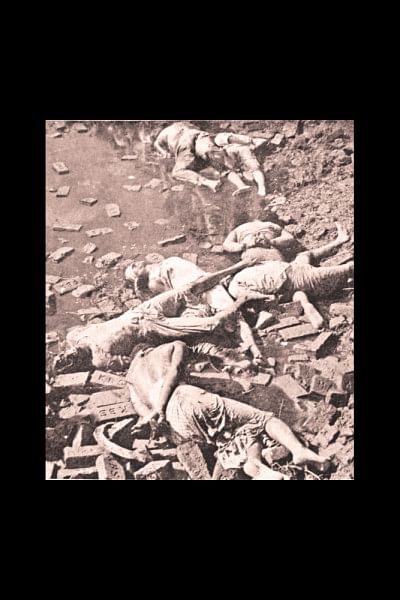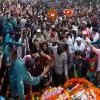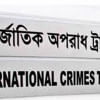Intellectuals' killing, not forgiven

He had a ruthless militia and an evil design at his disposal. And with those, he set out to intellectually cripple the soon-to-be independent Bangladesh.
Under the plan, which he along with his political colleagues and the Pakistan army had devised, the notorious militia Al-Badr massacred university teachers, doctors, journalists and other professionals towards the end of the Liberation War in 1971.
The country lost many of its brightest sons and daughters.
All these years, Ali Ahsan Mohammad Mojaheed, the AL-Badr chief and the man responsible for the savagery, has never showed any sign of repentance. Rather, after the 1975 assassination of Bangabandhu Sheikh Mujibur Rahman, he re-emerged in politics in the country against whose birth he had fought so hard.
Not only that, he went on to become a minister of the 2001-2006 BNP-led four-party government.
In an outrageous comment in 2007, he said there were no war criminals in Bangladesh.
Three years later, he was arrested in a war crimes case, and after another three years, he was sentenced to death by the International Crimes Tribunal-2 for the heinous crime of intellectuals' killing. Yesterday, the Supreme Court upheld the tribunal verdict.
Once the verdict is implemented, it would be the first execution of a war criminal for the killing of the intellectuals -- a loss the country still struggles to recover.
"The event of 'large scale killing of intellectuals' to further a common purpose under a designed plan that took place just a few days before the victory on 16 December 1971 terribly shocks the conscience of humankind and the Bangalee nation," said the tribunal verdict while narrating the nature of his atrocities.
Mojaheed joined Jamaat's student wing Islami Chhatra Sangha in 1965 when he was studying in Rajendra College in Faridpur.
His father Abdul Ali was the ameer of Faridpur Jamaat-e-Islami and a top leader of the local chapter of the anti-liberation Peace Committee.
Mojaheed, from 1968 until 1970, was the president of Faridpur district Chhatra Sangha.
Admitted to Dhaka University law department in 1971, he served as the president of Dhaka city Chhatra Sangha from January to July and became general secretary of the organisation's East Pakistan unit thereafter.
In October 1971, he became the president of the East Pakistan Chhatra Sangha.
After the Pakistan military crackdown in March 1971, the student organisation was turned into Al-Badr, Jamaat-e-Islami's "action section", according to the tribunal judgment delivered on July 17, 2013.
"The workers belonging to purely Islami Chhatra Sangha were called Al-Badr, the general public belonging to Jamaat-e-Islami, Muslim League, Nizam-e-Islami etc were called Al-Shams and the Urdu-speaking generally known as Bihari were called al-Mujahid," read the tribunal verdict.
The tribunal cited the above paragraph from a book titled "Sunset at Midday" by Peace Committee leader Mohi Uddin Chowdhury of Noakhali. Mohi Uddin left Bangladesh for Pakistan in 1972 and his book was published in 1998.
Being the top leader of the Chhatra Sangha and Al-Badr, Mojaheed visited many districts and held meetings with his followers, provoking them into killing freedom fighters as well as pro-liberation people, according to prosecution documents.
He and Motiur Rahman Nizami, another war criminal, took part in a meeting with the leaders and activists of Jamaat and Chhatra Sangha in Mymensingh on April 22, 1971.
At the meeting, Mojaheed said, "Al-Badr is a name! A wonder! Al-Badr is a commitment! Where there is a so-called freedom fighter, there is Al-Badr. Where there is a miscreant, there is Al-Badr. For the 'Indian agents' or the 'miscreants', Al-Badr is the Azrail [angel of death] incarnate."
Two days later, the Daily Sangram, the Jamaat mouthpiece, ran a report quoting from the speech.
During the war, the Pakistani occupation army set up a camp at Mohammadpur Physical Training Institute in Dhaka.
Mojaheed regularly visited the camp, which was also the headquarters and torture centre of Al-Badr. There he used to hatch conspiracy with the senior army officers to annihilate the "Bangalee population".
Rustom Ali Mollah, an eyewitness, who lived at the institute's quarters, testified before the tribunal that one day he saw Mojaheed at the camp, accompanied by Nizami and the then Jamaat chief Ghulam Azam.
Even two hours before the surrender of the Pakistani army on December 16, Mojaheed gave a speech at the headquarters, terming the day "painful" and the surrender a "tragedy".
He urged the Al-Badr members to spread wherever they could without being "ashamed" of their deeds, according to a book titled "Al-Badr" by Selim Mansur Khalid. The prosecution used this book as evidence.
"We have also carefully considered the accused's [Mojaheed's] position of authority through which he asserted his effective influence and control over the Al-Badr men and the Al-Badr headquarters in Dhaka city," said the ICT verdict.
Sensing defeat, the Al-Badr picked up intellectuals from their houses and took them to the headquarters, mostly from December 10 to 15.
The victims, who were among the best minds of the nation, suffered brutal torture before being killed and dumped in different killing fields in Rayerbazar and Mirpur.
Dhaka University teachers Prof Mofazzal Haider Choudhury, Prof Munier Chowdhury, Prof Giasuddin Ahmed, Prof Anwar Pasha, and Prof Santosh Chandra Bhattacharyya; journalists Serajuddin Hossain, Syed Najmul Haque, ANM Golam Mostafa, Nizam Uddin Ahmed, Selina Pervin, Shahidullah Kaiser, and physicians Fazle Rabbee and Alim Chaudhury were among the martyred intellectuals.
While the bodies of many of them were recovered from the killing fields, some were never found.

 For all latest news, follow The Daily Star's Google News channel.
For all latest news, follow The Daily Star's Google News channel. 








Comments